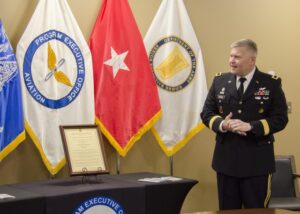NASHVILLE, Tenn. –As the Army emphasizes modular open system architecture (MOSA) as a key priority for its Future Vertical Lift (FVL) platforms and upgrades to its current fleet, a lead aviation official said this week the service is having success making the business case to industry to address “MOSA hesitancy.”
“[MOSA] is easy to say and it’s immensely complex to execute,” Brig. Gen. Robert Barrie, program executive officer for aviation, told attendees at the Army Aviation Association of America (AAAA) annual conference here. “What I hear from industry and a lot of folks is you’re not going to be able to do that for a variety of reasons. What I’ll tell you is we’ve gone to school on why we’ve been unable to succeed in the past with common approaches or with attempts to be open and iterate on capabilities over time. We’ve learned from that and we’ve evolved.”

Army aviation officials have cited MOSA as allowing rapid technology insertion and long-term cost savings on both future platforms and the enduring fleet, with Barrie previously saying the intent is to move away from bespoke configurations to enable the adding of individual technologies like an application downloaded on a phone (Defense Daily, May 3 2021).
“Describing that and communicating it and putting it into contracts is very challenging. It’s the largest challenge we have but the group is on board. We know the alternative is that we continue the status quo and if we do that we’re not going to be able to afford to bring capability at the speed that we’re going to need to do so,” Barrie told reporters during a briefing at the AAAA conference.
Barrie said the Army acknowledges if it’s going to be successful in getting after an open systems approach it will require industry “to operate in a less competitive space, in their own mind.”
“We’re asking industry to invest in an area that will, by definition, potentially reduce their competitive advantage. So there’s this natural inclination for them not to want to do this,” Barrie said during his address at the conference. “So what we’re trying to describe is that we want best-of-breed [capability]. We want industry to continue to be hungry and get onto our platforms But in order for them to do that it’s not going to be in the historical sense where they’re able to bring a very bespoke architecture and set of hardware and software and put that onto a platform and then have it on a platform for 10 or 20 years. Instead, it’s going to be software-centered and if it’s hardware then it’s going to be a card-type application that we will procure and pay and provide industry revenue for the time when that is the best capability we can give to our soldiers. And when it’s no longer the case, we want to be able to readily replace it with the next capability.”
Barrie said the FVL Architecture Collaboration Working Group, which now has over 700 members from industry, academia and government, has been an important forum for addressing “MOSA hesitancy” and enabling broader input on open architecture priorities.
“In this forum, here’s where we’re saying here’s our intent, here’s a broad description of this architecture and here our interfaces and here’s the modeling that we’re looking to communicate. Does this make sense? And if doesn’t make sense, how would you change it,” Barrie told reporters. “Through that group, I think we’ve been able to overcome what I would describe as the MOSA hesitancy. If an industry partner was hesitant on trying to embrace this, for a variety of reasons, how can we help them overcome that hesitancy.”
The Army is also embracing model-based systems engineering for its future aviation requirements, with Barrie citing it is an area where the service can learn best practices from industry to enable continuous integration and delivery of new system capabilities.
“Model-based systems engineering is already the standard in most industry applications. It is not today inside the government. We’re changing that,” Barrie said. “This is new for the government. It requires changing the way we contract for our systems, the way we provide revenue streams to our industry partners over time.”